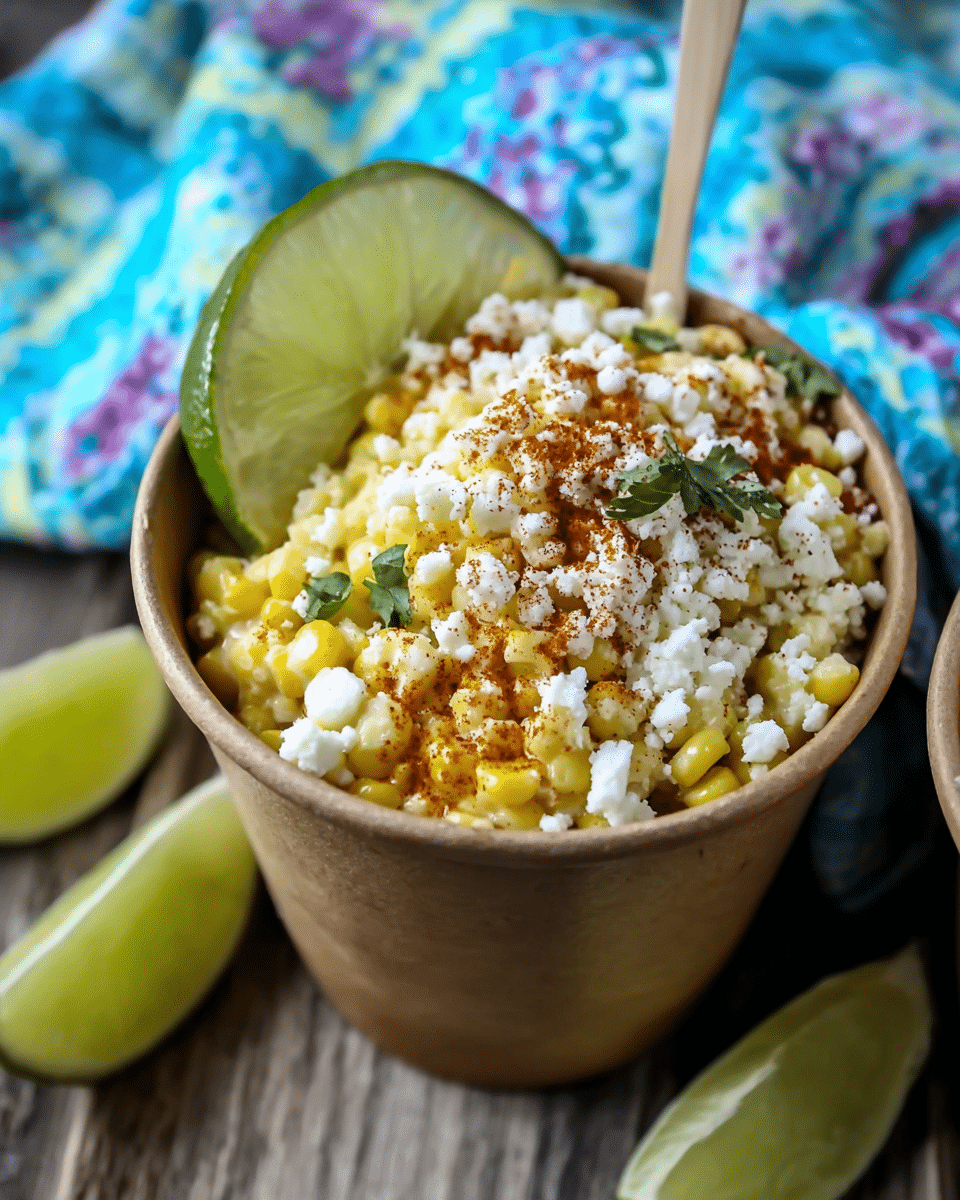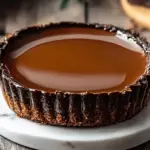The beauty of Esquites lies in its simplicity and comfort. This dish brings the essence of Mexican street food to your table with buttery corn kernels simmered to perfection, then adorned with creamy mayo, tangy lime, savory cotija cheese, and a dusting of chili powder.
Whether you enjoy it at a family gathering, a summer barbecue, or as a warm snack on a cool evening, Esquites deliver bold flavor in every spoonful. They’re also incredibly adaptable go heavy on the lime, throw in extra chili for heat, or make it more indulgent with an extra dollop of crema. This beloved corn-in-a-cup recipe is a delicious testament to Mexico’s culinary soul.
Full Recipe:
Ingredients:
-
6 cups white corn kernels (fresh or frozen)
-
1/2 white onion, finely chopped
-
3 cloves garlic, finely chopped
-
3 tbsp butter
-
Salt to taste
-
1 sprig fresh epazote (optional but recommended)
-
5 cups water
Accompaniments:
-
1/2 cup cotija cheese
-
1/2 cup Mexican crema
-
1/2 cup mayonnaise
-
Lime juice to taste
-
Hot sauce or chili powder to taste
Directions:
-
In a large pan, melt the butter over medium heat. Add the chopped onion and garlic, sautéing until the onion becomes translucent.
-
Add the corn kernels and cook for about 5 minutes, stirring occasionally.
-
Pour in the water, add the epazote (if using), and season with salt.
-
Bring to a boil, then reduce the heat and let simmer uncovered for 20 minutes.
-
Serve hot in cups. Top each serving with cotija cheese, Mexican crema, mayonnaise, a squeeze of lime juice, and a dash of chili powder or hot sauce. Stir well and enjoy immediately!
Prep Time: 5 minutes | Cooking Time: 25 minutes | Total Time: 30 minutes
Kcal: 291 kcal | Servings: 8 servings
The Soul of Mexican Street Food: Esquites (Mexican Corn Salad)
There’s a special kind of magic in Mexican street food vibrant flavors, textures, aromas, and traditions all wrapped into dishes served with a warm smile on a bustling street corner. One of the most beloved of these is Esquites, a warm and savory corn salad that offers a comforting taste of nostalgia for many Mexicans, and an unforgettable introduction to Mexican cuisine for the uninitiated.
Though simple at first glance, esquites represent far more than just a bowl of cooked corn. They carry regional pride, ancestral techniques, and culinary creativity that have evolved over generations. Whether served from a street cart in Mexico City or in a stylish bowl at a gourmet restaurant, esquites are a testament to the enduring power of humble ingredients transformed through tradition.
What Are Esquites?
The word esquites is derived from the Nahuatl word ízquitl, which means “toasted corn.” Unlike its popular cousin elote corn served on the cob esquites are prepared by removing the kernels from the cob and cooking them with a flavorful base before being topped with a medley of rich and zesty accompaniments. Traditionally, they are served hot in a cup and eaten with a spoon, making them not only delicious but also convenient for on-the-go enjoyment.
A serving of esquites is warm, creamy, tangy, slightly spicy, and savory, with layers of flavor from ingredients like mayonnaise, cotija cheese, lime juice, chili powder, and Mexican crema. Depending on the region, a sprig of epazote, a pungent Mexican herb, is often added during cooking for an earthy depth of flavor.
Cultural Roots and Regional Identity
Esquites are far more than a snack they’re ingrained in Mexican culture. You’ll find them at birthday parties, neighborhood gatherings, festivals, markets, and even late-night street corners. From children lining up with coins clutched in their hands to adults craving a midnight treat, esquites span generations and social classes.
Though widely loved throughout the country, regional variations add unique character to esquites. In central Mexico, for example, they’re typically simmered in broth with epazote and garnished with lime, cheese, and chili powder. In the Yucatán Peninsula, however, local herbs and spices may take center stage, lending different aromas and colors to the dish. In Veracruz, cooks sometimes incorporate shrimp or other seafood for a coastal spin.
Some areas may even refer to esquites with different names altogether. In certain states, the dish might be known as trolelote, a portmanteau of elote and trolebús (trolley), referencing the mobile nature of food carts in urban areas. These linguistic nuances only add to the rich tapestry of esquites’ identity across Mexico.
Street Food Staple and Modern Reinvention
Walk down any busy street in Mexico in the late afternoon or evening, and you’re likely to find a vendor with a large metal pot full of simmering corn. The smell alone is enough to draw you in buttery corn, sharp onions, warm epazote, and an occasional hint of smoky chili floating through the air. The vendor ladles steaming corn into disposable cups, layers it with the condiments of your choice, and hands it over with a plastic spoon. It’s simple, satisfying, and absolutely delicious.
What makes esquites particularly special is their customizability. Some prefer extra lime juice for a tangy punch; others pile on chili powder for heat. There’s a version for everyone, and no two cups are exactly the same.
In recent years, esquites have made their way beyond the streets and into upscale restaurants and food festivals across the U.S. and globally. Chefs in cities like Los Angeles, New York, and London have taken inspiration from this traditional dish, creating fusion versions with ingredients like truffle oil, feta cheese, roasted garlic, and chipotle aioli. Despite these gourmet reinventions, the heart of esquites remains unchanged: it’s a dish born from the land, perfected by generations, and loved by all.
Nutrition and Comfort in a Cup
From a nutritional perspective, esquites can be seen as both indulgent and balanced, depending on the version you’re enjoying. Corn itself is high in fiber, natural sugars, and essential vitamins like B-complex and C. When paired with cheese and crema, the dish gains calcium and protein, though also a fair bit of fat and sodium. The addition of fresh lime juice adds a dose of vitamin C, while chili powder provides capsaicin, known for its metabolism-boosting properties.
For those seeking lighter options, esquites can be made with Greek yogurt in place of mayonnaise and crema, or without cheese altogether. Roasted or grilled corn kernels can also be used for a smoky flavor and a reduction in overall richness.
But more than nutritional stats, esquites offer emotional nourishment. They evoke childhood memories, neighborhood aromas, and the comforting sound of vendors calling out their wares. Few dishes manage to be this personal and communal at the same time.
The Role of Epazote and Other Traditional Touches
One of the unique ingredients that separates authentic esquites from their more Americanized adaptations is epazote, a wild herb native to Central and South America. Known for its distinct pungent aroma, epazote is often added to the boiling corn and contributes a slightly medicinal, earthy flavor that can’t quite be replicated with Western herbs. It also has the added benefit of aiding digestion a trait appreciated when enjoying bean- or corn-heavy meals.
Epazote may not always be easy to find outside of Latin America, but it is available in dried form in many international markets and online. Those seeking authenticity in their esquites are encouraged to seek it out it’s a small touch that connects the modern dish to its ancestral roots.
Serving Traditions and Pairings
Esquites are typically enjoyed on their own as a street food snack, but they can also be paired with other Mexican favorites like tamales, tacos, tostadas, or quesadillas. The dish works well as a side for grilled meats or seafood, particularly at summer cookouts and family gatherings. Its portability and versatility have made it popular at festivals and casual get-togethers, where it’s easy to serve in bulk without losing flavor or texture.
As a serving tradition, many street vendors present esquites in plastic or Styrofoam cups, handed out with small spoons or forks. More upscale versions may appear in ceramic bowls, but the rustic charm of the paper cup presentation remains iconic.
Why Esquites Endure
In a culinary world obsessed with novelty, few dishes endure like esquites. Its enduring popularity comes down to a combination of cultural pride, nostalgic familiarity, bold flavor, and simple satisfaction. It’s a dish that doesn’t need frills or trends to stay relevant it just needs to be shared.
As people move across borders and recipes travel through social media, food blogs, and international kitchens, esquites continue to gain recognition. They represent the flavor of a country, the creativity of its people, and the resilience of tradition in the face of modernity.
Conclusion:
Esquites may be served in humble cups on a busy street, but they carry within them the essence of Mexican culture generosity, boldness, warmth, and heritage. Whether you’re enjoying them in their traditional form with epazote and lime or exploring a modern twist with grilled corn and chipotle mayo, each bite connects you to a story that spans centuries.
Adding esquites to your culinary repertoire means more than learning a new recipe it means embracing a dish that has fed families, fueled street life, and brought people together across generations. So the next time you crave something comforting, zesty, and full of character, let a cup of esquites be your guide to the rich world of Mexican street cuisine.






